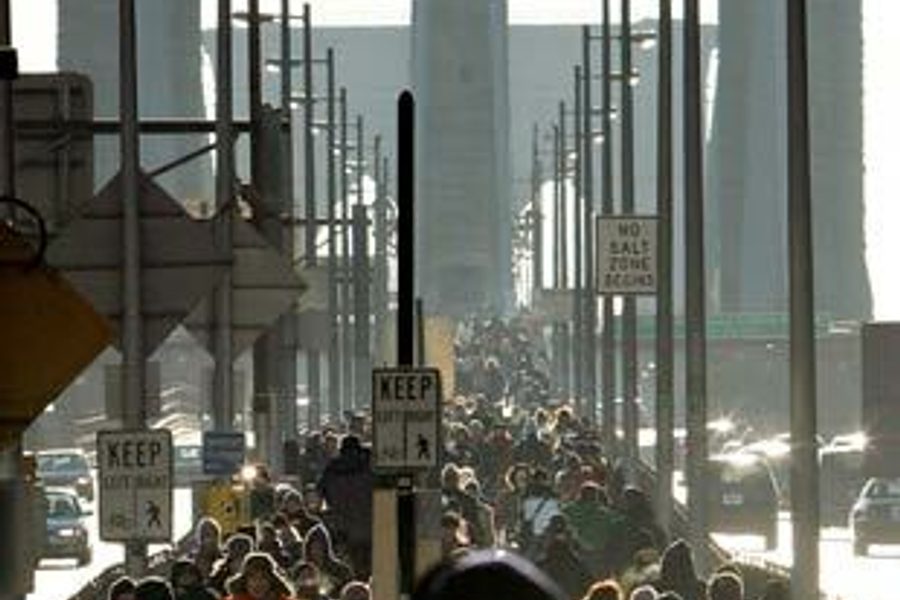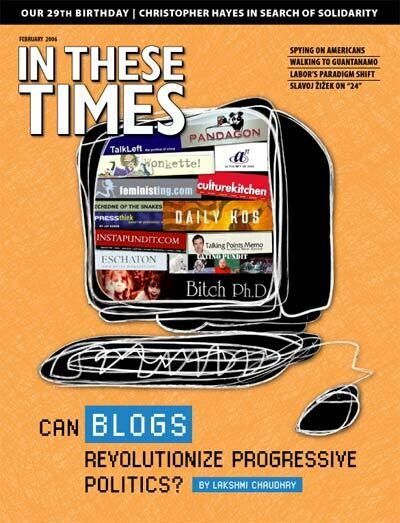
It’s a week before the holidays in New York City and there’s a transit strike. A strike? In 2005? It seems an anachronism, like meat rations or air raid drills. There’s a frisson of excitement in the air mixed with logistical dread and disbelief.
The morning the strike begins, billionaire mayor Mike Bloomberg accuses the largely black and Latino union of acting “thuggishly” and then proceeds to class-bait the transit workers. “You’ve got people making $50,000 and $60,000 a year keeping the people who are making $20,000 and $30,000 a year from being able to earn a living,” he says. “That’s just not acceptable.”
This sums up the narrative for nearly all of the local press coverage: scowls of harried commuters waiting in line, shots of the hapless souls trudging across the Brooklyn Bridge, an icon of the city in crisis that evokes both the strange thrill of the ‘03 blackout and the horror of 9/11; frenzied live reports from the Mad Max death-cage that is Penn Station; and interviews with grimacing truck drivers banned from entering south of 96th street, waiting to catch hell from their bosses. The message: New Yorkers are pissed, as only New Yorkers can be, at the malcontents who left them to fend for themselves amidst the holiday crush. “I wish we still had Reagan,” one man says in a typical sound bite. “He would have fired the whole lot of them.”
Among liberals – people who loathe Bush, oppose the war, favor national healthcare – there’s an ambivalence about the strikers’ demands: Who gets to retire at 55 with a half-salary pension? The New York Times editorial page calls the strike “unnecessary,” the union’s account of negotiations “ridiculous,” and bellows that TWU Local 100 president Roger Toussaint “should not have the ability to hold the city hostage.”
But despite the near-unanimous condemnation by the city’s mandarins and negative round-the-clock coverage, New Yorkers, astonishingly, support the strikers.
I get an inkling of this when I walk past an MTA bus depot in East Harlem on the strike’s second day. Instead of a riotous mob shouting insults, cars honk approval as they zip past the picketers.
Polls commissioned by local news outlets bear this out, though you’d hardly know it from the coverage. One, commissioned by a local ABC affiliate and conducted by Survey USA on the first day of the strike, asked the question: “In the transit strike … whose side are you on?” Fifty-two percent of respondents said the union. Forty percent said the MTA. A poll from local radio station WWRL found that 71 percent of respondents blamed the MTA for the strike and 14 percent blamed the union. A poll by local cable channel NY1 found a majority of New Yorkers thought the union’s demands “fair.”
The real story of the strike is not the epic hassle it created. It is the fact that despite universal condemnation from opinion makers, millions of New Yorkers were in solidarity with the strikers.
Solidarity. Now there’s an anachronism. The news media doesn’t talk about solidarity; it employs the assured and peppy tone that speaks to the individual consumer: After the break: We’ll tell you how the strike will affect your morning commute. Solidarity is the opposite of news you can use. No wonder the local media missed the real story. It hinged on a concept that is not part of its vocabulary.
The word “solidarity” may seem the sole provenance of the “left” and the “dying” labor movement, but the strike showed that whether we give it a name or not, people still feel it.
In Which Side Are You On?, Tom Geoghegan writes that solidarity is “the only love left in this country that dare not speak its name.” Enter the word into Google news and you’ll find that in English-language papers from Lahore to Leeds, the word pops up frequently. Not so here. In American publications it appears, if at all, only in neutered form – the simple presence of group cohesion. A company sponsoring a retreat for its employees does so to encourage “corporate solidarity.” Bloomberg’s appearance on the Brooklyn Bridge on the strike’s first morning is described as a “show of solidarity” with stranded commuters.
Yet the word retains a specific moral force. I remember the thrill I felt when I received a correspondence from a union organizer who signed off, “In solidarity.” It felt, at once, a generous invitation to fellowship, and a moral call to arms. I took to signing off correspondences with it.
Recently, an editor I respect wrote to tell me that she and another editor had asked each other: “What the heck is he doing, signing his letter with that?” I asked her what was startling about it. Did it seem strange for a journalist to invoke it? Was it contrived? All of the above, she replied. I e-mailed a conservative friend. Should I not have used it? Did he think it strange, offensive? “Definitely not offensive,” he wrote back. “Might be a bit silly, but not offensive.”
The current state of solidarity in a nutshell: at once too strident and too silly.
Through our blood it runs
The Oxford English Dictionary defines “solidarity” as: “The fact or quality, on the part of communities … of being perfectly united or at one in some respect, esp. in interests, sympathies, or aspirations.” It comes from the same Latin root as “solid” and is adapted from the French solidarité, which by the 19th century, had supplanted the “fraternité” of the French Revolution as the social glue for the impending era of enlightened utopia. Whereas “brotherhood” relied on personal intimacy and a vestigial Christian conception of fellowship, solidarity was capacious enough to lasso together enormous clusters of strangers, perhaps even all of humanity. It soon became a buzzword. At the 1900 World’s Fair, the French minister of trade announced solemnly, “Science reveals to us society’s material and ethical secret, which may be summarized in one word – solidarity.”
In the mid-19th century, solidarité crossed both the English Channel and the Atlantic. Sven-Eric Liedman, a professor of intellectual history at Sweden’s Göteborg University, writes that Americans were skeptical of the French import: In 1844, one American complained of “the uncouth French word, solidarité, now coming in such use.” While the word never quite gained the same cachet it had (and continues to have) in Europe, the American left quickly adopted it. Solidarity was the name of an early anarchist journal. Eugene Debs said solidarity was “a fact, cold and impassive as the granite foundations of a skyscraper.” And, in 1915, Ralph Chaplin of the Industrial Workers of the World wrote the labor anthem “Solidarity Forever” to the tune of “Battle Hymn of the Republic.”
Solidarity in the political vocabulary of the American left became class solidarity, workers’ solidarity, the banding together of laborers against bosses. But it possessed more than rhetorical resonance, it was also the foundation of the labor movement’s most potent tool: the strike. Only if workers stuck together under incredible pressures – violent intimidation from Pinkerton thugs and national guardsmen with rifles – could a strike be successful. In the 1880s and 1890s, as members of the Knights of Labor struck across the country for an eight-hour day, its motto was: “An injury to one is the concern of all.”
Years later, the United Auto Workers, born of a series of dramatic sit-down strikes in the 1930s, named its headquarters Solidarity House, its publication Solidarity; at its 1970 convention Walter Reuther told the delegates: “We have taken on the most powerful corporations in the world and despite their power and their great wealth, we have always prevailed, because … there is no power in the world that can stop the forward march of free men and women when they are joined in the solidarity of human brotherhood.”
While in the United States, the word has been ghettoized in the labor movement, solidarity in Europe remains part of mainstream political vocabulary. The labor rights guaranteed in the European Union charter are collectively referred to as “rights to solidarity.”
Of course, any word that packs a moral punch will soon find itself appropriated by political hucksters. To wit: For last year’s State of the Union, Rep. Bobby Jindal (R-La.) organized fellow Republicans in a display of “solidarity” with the Iraqis who had just voted in their first election in decades. “Congress Dons Purple Clothes, Ink, for Solidarity with Iraqis,” read the AP headline. In addition to their ink-stained fingers, the article noted, “Several women, including newly appointed Secretary of State Condoleezza Rice, traded their red suits for violet.”
From workers’ struggle to Condoleezza Rice’s evening wear – what a long, strange trip it’s been.
The mundane and the sublime
As elusive as its meaning may be, from the amorphous cloud of centuries’ worth of usage and citations, two general categories of solidarity emerge: the mundane and the sublime.
In its mundane sense, solidarity means a robust feeling of togetherness, a “one-for-all, all-for-one-ness” that holds fast a group of people in a common activity. It is best summed up in Benjamin Franklin’s exhortation to his co-conspirators that they must all hang together or surely they would hang separately. This kind of solidarity is morally neutral. Union members refusing to cross a picket line exemplify solidarity, but so do white homeowners in a Chicago neighborhood signing restrictive covenants to keep black families out.
Sublime solidarity, on the other hand, embodies a powerful moral aspiration to realize the fundamental fellowship of humankind. The human subject imbued with full solidarity would treat each person the same way she would treat the interests of her closest kin. My father, a community organizer and one-time Jesuit seminarian, explains why solidarity is his favorite word by sketching a continuum that ranges from pearl-clutching pity through sympathy and empathy to arrive finally at solidarity, wherein you are propelled to do something for your fellow human beings, to act as if their interests were your own.
It is this solidarity Jane Addams described as “not philanthropy nor benevolence, but a thing fuller and wider than either of these,” and what Gandhi referred to when he spoke of the “essential unity of all people.”
As a practical matter, sublime solidarity is nearly impossible to live on a day-to-day basis. Philosopher Richard Rorty argues that while a conception of solidarity is the basis for human moral progress, people rarely act out of solidarity with “all humanity,” but rather some specific group with whom they feel joined. Meditating on the fact that Danes and Italians were far more willing to hide and protect their Jewish neighbors during the holocaust than were, say, Belgians, Rorty asks:
Did they say, about their Jewish neighbors, that they deserved to be saved because they were fellow human beings? Perhaps sometimes they did, but surely they would usually, if queried, have used more parochial terms to explain why they were taking risks to protect a given Jew – for example, that this particular Jew was a fellow Milanese, or fellow Jutlander, or a fellow member of the same union or profession, or a fellow bocce player, or a fellow parent of small children.
As Rorty demonstrates, mundane solidarity can be a gateway to something far higher, but just as often it leads to moral quandaries. Mundane solidarity requires allegiance and loyalty to a specific group. You must choose which side you are on; make that side’s friends your friends, its enemies your enemies. But not all choices are as stark as those between a fellow bocce ball player and the Gestapo. More often we are faced with competing calls to solidarity from conflicting parties, each deserving of our allegiance. Sublime solidarity requires us to cast our lot with humanity itself, to somehow be on everyone’s side at the same time: both the brutalized Kurds and dissidents who suffered untold horrors at Saddam Hussein’s hands and the tens of thousands of families who’ve watched their loved ones killed by an occupying army.
What the great social movements of our time have been able to accomplish is to find the sweet spot between the mundane and often blinkered solidarity of specific communities of interest, and the grandiose but vague notion of the solidarity of all humanity. From the labor battles of the ’30s, to the Gandhian independence struggle, to civil rights and anti-apartheid movements, the most uplifting and effective social movements have oriented themselves towards sublime solidarity while remaining grounded in the mundane but robust cohesion of a specific group with specific aims and specific demands. We may remember moments of moral progress for their dramatic or transcendent quality, but they were first and foremost political victories born of a refusal to pull apart. Such solidarity is the left’s proudest tradition, both here and abroad: the unity of purpose and determined fellowship among those battling an unjust order combined with a constant effort to stretch that fellowship to ever larger groups of citizens.
In 1980, as a general strike spread throughout Poland, the Communist government tried an old ruse. Realizing the strike’s spiritual and organizational center was the Lenin Shipyard in Gdansk, the government tried to buy off its workers with a pay raise. Take the money, they said, call off the strike. The trick had worked in the past. But the young dock worker Lech Walesa, fired four years earlier for agitating for free trade unions, said no deal: The strike was no longer a strike for workers’ wages at the Lenin Shipyard, but a strike in solidarity with all the others around the country. It wouldn’t end until the demands of the new political organization, Solidarity, were met.
In New York, a similar though less dramatic choice faced the TWU and Roger Toussaint. The MTA made a last minute offer to the union that would have maintained the pensions of current members, but forced new workers to pay a significantly higher percentage of their income. Accepting the offer would have been no skin off current workers’ noses. But Toussaint angrily refused to sell out the union’s “unborn.”
Solidarity and its uses
While solidarity can be inculcated, most often it is born of crisis. It reveals itself most fully when tested: on the picket line, on the bridge in Selma, in the rubble of collapsed towers. In an eerily prescient essay on the “Uses of Disaster” in October’s Harper’s (it went to print the day Katrina hit), Rebecca Solnit investigated the odd elation and intense feeling of fellowship and mutual aid that comes in the wake of mass tragedy. “Again and again,” she wrote, “we see a latent civil society – a community – arising from the ruins of some disaster and becoming the grounds for connection and joy.”
It is for this reason that 9/11 occupies a strangely affectionate place in the nation’s collective memory. What we recall is the profound solidity of our feelings of togetherness, the empathic stretching that took place: Gentiles in Georgia weeping for dead Jews in Brooklyn. The nation and “our community” were suddenly indistinguishable, which is, at their best, what all those flags waving from front porches and SUVs represented. Hendrik Hertzberg wrote of this “newfound solidarity” in the New Yorker, “All of us have seen it and felt it in a variety of small and large ways, in gentler, politer interactions with friends and strangers; in an outpouring of charitable giving and volunteer activity; in tableaux of fellowship among political and civic leaders.”
We sought an outlet for this sentiment: We lined up to give blood, held bake sales and fundraisers, made strange and solemn pilgrimages to the hallowed Ground Zero. But what came of it? Another leader could have used 9/11 to connect Americans to the grieving of the world, to the mothers in Colombo, Chechnya and the Congo also weeping for their children. Another leader could have called for, and would have gotten, a massive increase in American foreign aid. Another leader could have institutionalized an outlet for this feeling of national solidarity in some form of non-military national service.
Instead, we were told to shop. “Get on board,” said Bush on September 27, 2001, at Chicago’s O’Hare International Airport. “Get down to Disney World in Florida.”
From the moment the scale of the attacks were understood, the Bush administration has done everything in its power to tease out the tribal, nationalistic and reactionary threads of this impulse toward togetherness and weave them into a political yoke that keeps the electorate docile and unquestioning. Though the world reached out to the United States in solidarity – remember Le Monde’s September 12 editorial “We Are All Americans Now” – the administration steered us toward nationalism and then to jingoism. As the fall of 2001 turned to winter, those flags took on a darker, uglier cast.
Four years later, nearly to the day, Americans watched the victims of Katrina left to die by their own government, and felt a rage surprising in its intensity. In a bracing turn of events, the media, when it wasn’t hyping lurid hysteria about cannibalism and roving gangs, adopted the indignant tone that solidarity would demand. TV news personalities stopped reporting on those who were stranded and suffering and started reporting from those who were stranded and suffering. Shepard Smith of Fox News, after railing against the fact that police had barred evacuees from walking over a bridge to Gretna, Louisiana, was interrupted by his colleague Sean Hannity, who was sitting comfortably in a New York studio. “I want to get some perspective here,” Hannity said smugly. “That is perspective!” Smith angrily shot back. “That’s all the perspective you need.”
But what was the outlet for this sentiment? A donation. Even if solidarity was what America felt – a debatable proposition given the bevy of retrograde racism that found expression in the hurricane’s aftermath – the country had no prescribed way of converting sentiment into action other than to call the Red Cross and take out the Visa. But donating money is an act of charity, not solidarity. Once we’ve paid off our conscience we’re free to go back to our lives. That’s the problem with pity: It severs so easily.
In order to turn the sentiment of solidarity into concrete political gain and moral achievement, you need organization. And organization is what we lack.
What would we call such an organization, one whose explicit purpose is to foster solidarity?
A union?
With the decline and possible death of the American labor movement, we will lose not only a voice for equality and redistribution at a time when such ideas seem as quaint and vestigial as blood-letting and weather-gods. We will lose a fundamental conception of human togetherness, an understanding that our self-interest is inextricably bound with the interests of others who we may not even know. We will lose a form of mundane solidarity that doesn’t rely upon medieval associations of faith, kind or clan, one that requires that we push out the edges of who we think of as “us.”
If we lose unions, we lose the concept of solidarity itself. And it’s hard to imagine we won’t become worse people for it.
Right now, our politics are atomized and transactional: we send checks, we sign petitions, we forward articles. We buy sweat-free clothes, recycle and look for vocations that don’t collude too egregiously with evil. But we’ve unconsciously circumscribed the boundaries of political action. What is MoveOn’s equivalent of a strike? As union membership and urban ethnic machines decline and the “netroots,” overwhelmingly white and affluent, comes to represent the progressive movement, the left is in danger of becoming, as Thomas Frank wrote in Le Monde Diplomatique in February 2004, “a charity operation.” That is, “people in sympathy with the downtrodden, not the downtrodden themselves.”
As the American right offers that redundant canard “moral values” as its lodestar, the left should offer solidarity. Not retrograde brotherhood, or faith-specific fellowship, but something more robust and difficult and rewarding. The uplift of collective enterprise.
There is no alternative
In an America that fetishizes both the revealed wisdom of the individual consumer and the pursuit of “personal growth” through ceaseless introspection, nurturing an ethos of solidarity is no small task. But if it seems abstract or unattainable, consider the alternative, posted by one angry New Yorker on the TWU’s message board:
Dear scumbag TWU membership: If I ran the MTA, I’d can each and everyone one of you. And then I’d automate everything possible about the subway by eliminating the mindless idiots who work in the “information” booths (you’ve already been replaced by a vending machine – now you’re just stealing oxygen), the morons who look out of the subway train with the stupid wrap-around glasses, and the sullen cleaning crews who look like they’d mug you before picking up the trash on the platform … A pack of trained monkeys could do your job better. And they’d probably be a hell of a lot more grateful for it, too. Do you even realize how outlandish your demands are? Retirement at 55 – are you kidding? Do us all a favor and don’t come back to work.
Such sentiment is not fringe. Despite a majority of New Yorkers siding with the union, millions saw in the strike a greedy special interest whose fight for better benefits was an insult to their own lack thereof.
The opposite of solidarity is dog-eat-dog, which, if we had to choose a motto for the last quarter century of American history, would work as well as any.
If there’s a city where dog-eat-dog is at its most ferocious, it is of course, New York. All the more amazing then, how at a time of maximum stress New Yorkers could remind us that we still can walk a mile in someone else’s shoes.








